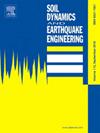考虑有效土塞的开放式管桩高应变动力分析模型
IF 4.2
2区 工程技术
Q1 ENGINEERING, GEOLOGICAL
引用次数: 0
摘要
开放式管桩(OEPPs)广泛用于海上基础,但由于土塞的复杂性,准确预测其驱动响应仍然具有挑战性。现有的打桩分析模型没有充分表征土塞的影响,可能导致打桩过程中出现拒锤、打桩、结构破坏等问题。本文提出了一种有效的土壤堵塞(ESP)模型,用于OEPP驱动分析。ESP模型考虑了土塞的有效范围,其内阻随深度呈指数增长,而有效范围之外仅影响质量惯性。这也解释了桩-土塞界面的相对滑移。提出了一种求解ESP模型的微分迭代法。随后,进行了模型验证和参数分析等研究。针对现有模型和现场测量的模型验证证实了ESP模型的可靠性。参数敏感性分析揭示了土塞长度和内阻分布类型对桩动力响应的重要性。此外,当土塞发生滑移时,土塞位移峰值随深度增加而不是一维波衰减。此外,与以往的连续滑移假设相反,土塞在长时间冲击载荷作用下呈现不连续的“跳滑”模式。研究结果为OEPP驱动仿真及高应变动态试验解释提供了理论依据。本文章由计算机程序翻译,如有差异,请以英文原文为准。
High-strain dynamic analysis model of open-ended pipe piles that considers effective soil plug
Open-ended pipe piles (OEPPs) are widely used in offshore foundations, yet accurately predicting their driving responses remains challenging due to soil plug complexities. Existing pile driving analysis models inadequately characterize the effects of soil plug, potentially leading to driving problems such as hammer refusal, pile running, and structural damage. This paper proposes an effective soil plug (ESP) model for OEPP driving analysis. The ESP model considers the effective range of soil plug, which exerts internal resistance that increases exponentially with depth while the beyond of effective range contributes only mass inertia. It also accounts for the relative slippage at the pile-soil plug interface. A differential iterative method is developed to solve the ESP model. Subsequently, investigations including the model validation and parameter analysis are conducted. Model validations against existing models and field measurements confirms the reliability of the ESP model. Parameters sensitivity analysis reveals the importance of soil plug length and distribution type of internal resistance on the pile dynamic responses. In addition, if soil plug slippage occurs, the displacement peak of soil plug increases with depth rather than one-dimensional wave attenuation. Furthermore, contrary to previous assumptions of continuous slippage, the soil plug experiences a discontinuous “jump-sliding” mode under long-duration impact loading. These findings provide theoretical basis for OEPP driving simulation and interpretations of high-strain dynamic test.
求助全文
通过发布文献求助,成功后即可免费获取论文全文。
去求助
来源期刊

Soil Dynamics and Earthquake Engineering
工程技术-地球科学综合
CiteScore
7.50
自引率
15.00%
发文量
446
审稿时长
8 months
期刊介绍:
The journal aims to encourage and enhance the role of mechanics and other disciplines as they relate to earthquake engineering by providing opportunities for the publication of the work of applied mathematicians, engineers and other applied scientists involved in solving problems closely related to the field of earthquake engineering and geotechnical earthquake engineering.
Emphasis is placed on new concepts and techniques, but case histories will also be published if they enhance the presentation and understanding of new technical concepts.
 求助内容:
求助内容: 应助结果提醒方式:
应助结果提醒方式:


